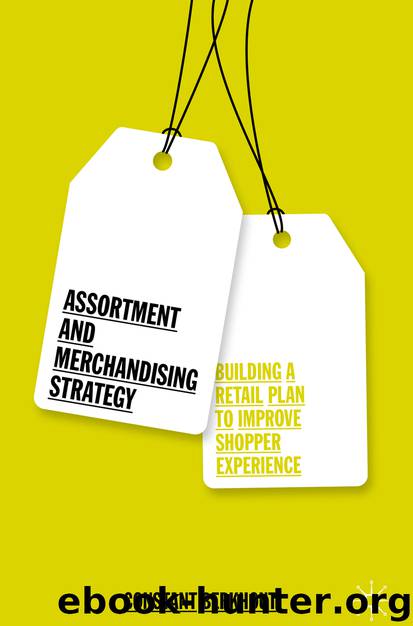Assortment and Merchandising Strategy by Constant Berkhout

Author:Constant Berkhout
Language: eng
Format: epub
ISBN: 9783030111632
Publisher: Springer International Publishing
Learnings on Search Behaviour from Eye-Tracking Studies
A great way to discover how shoppers search in a shopping environment is to invite shoppers to wear eye-tracking glasses. This research method provides great insights on what shoppers actually see. Much of the way shoppers perceive the retail context is the same; however, practitioners should carefully watch for differences in their target groups. For example, the outcomes often greatly depend on the experience of the shopper with the category and the context provided in online versus brick-and-mortar stores. For example, shoppers who are familiar with the planogram point their attention immediately to their reference product. If the purchase frequency is very low, shoppers may adopt a more systematic method such as browsing the product offer from left to right.
In an article by Chandon and colleagues (2009), a useful overview is given of how the eyes of shoppers move around the product assortment. It seems people’s eyes make smooth and conscious movements; however, eye-tracking studies show that our eyes make rapid jumps, called saccades, from one point to another. On these points, the eye rests for a moment; in fact it is a small rest of 0.2–0.5 seconds per fixation. The saccade takes even less time, 0.02–0.04 seconds, and moves away 3–5 degrees in distance. During saccades no relevant information from the retail context is absorbed. This is different for the fixations. Fixations are a requirement for the identification of objects and therefore an analysis of fixations tells retailers what shoppers have seen. The visual area of a fixation is really small, about twice the width of the thumb if the arm is stretched out. It is a superior view on a small area. Eye fixations help memorise the object, while objects perceived only in periphery are not stored. The first eye fixation delivers a lot of information to the shopper. In combination with a less detailed view on the periphery the first fixation identifies the meaning of the context (‘this is the coffee category in a supermarket aisle’), the spatial construction (‘there are seven shelves’) and the level of complexity and disorder. Shoppers need more fixations to get to know brands and identify which particular products are available. In eye-tracking studies, the first fixation on an object is known as noting. The information comprised in half a second gives shoppers a hint if this is what they searched for. If the object is noted depends on characteristics of the object, previous fixations on other objects in the retail context and a priori knowledge and experience. The second fixation on the same object is re-examination. For this to happen, the object is required to have a relationship with the particular shopping task.
Download
This site does not store any files on its server. We only index and link to content provided by other sites. Please contact the content providers to delete copyright contents if any and email us, we'll remove relevant links or contents immediately.
| Direct | Global |
| Industrial | Multilevel |
| Product Management | Research |
| Telemarketing | Web Marketing |
Influence: The Psychology of Persuasion by Robert B. Cialdini(4716)
The Miracle Morning by Hal Elrod(4640)
The Hacking of the American Mind by Robert H. Lustig(4319)
Pre-Suasion: A Revolutionary Way to Influence and Persuade by Robert Cialdini(4153)
Unlabel: Selling You Without Selling Out by Marc Ecko(3592)
Ogilvy on Advertising by David Ogilvy(3518)
Hidden Persuasion: 33 psychological influence techniques in advertising by Marc Andrews & Matthijs van Leeuwen & Rick van Baaren(3476)
Purple Cow by Seth Godin(3143)
Who Can You Trust? by Rachel Botsman(3089)
Kick Ass in College: Highest Rated "How to Study in College" Book | 77 Ninja Study Skills Tips and Career Strategies | Motivational for College Students: A Guerrilla Guide to College Success by Fox Gunnar(3077)
The Marketing Plan Handbook: Develop Big-Picture Marketing Plans for Pennies on the Dollar by Robert W. Bly(2978)
This Is Marketing by Seth Godin(2974)
I Live in the Future & Here's How It Works by Nick Bilton(2938)
The Power of Broke by Daymond John(2900)
Building a StoryBrand by Donald Miller(2843)
The Tipping Point by Malcolm Gladwell(2829)
The 46 Rules of Genius: An Innovator's Guide to Creativity (Voices That Matter) by Marty Neumeier(2799)
Draw to Win: A Crash Course on How to Lead, Sell, and Innovate With Your Visual Mind by Dan Roam(2740)
Market Wizards by Jack D. Schwager(2645)
